In this guide, we’ll bounce through the essentials of how to choose a trampoline, from size and shape to durability and bounce height, ensuring you land the perfect fit for your backyard.
Get ready to jump into a world of fun with insights that will keep you soaring.
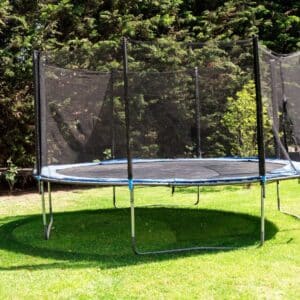
Consider Who Will Be Jumping on The Trampoline
Firstly consider the age and number of the people who will be jumping on the trampoline as this heavily affects the size, shape and maximum weight of your eventual choice.
Outdoor trampolines have a weight limit of anywhere between 100Ibs to 750Ibs so if you plan on having something for yourself as well as the kids, you’ll need to pay attention to the manufacturers guidance on weights.
Choose the Right Shape Trampoline
There are several shapes of outdoor trampolines commonly found in backyards, each suited to slightly different jumpers.
Round Trampolines
Round trampolines are the most common and widely available type. They are typically designed for general bouncing and are suitable for recreational use. Round trampolines provide a consistent bounce and tend to direct users toward the center, making them a popular choice for families.

Rectangular Trampolines
Rectangular trampolines are known for their superior bounce quality and are often preferred by gymnasts and tumblers. They offer a higher bounce at the ends and a more controlled bounce in the center.
Rectangular trampolines are ideal for gymnasts looking to practice tumbling skills like cartwheels, round offs or back handsprings as these types of skills travel along a distance rather than just jumping vertically.
Discover our top picks of Rectangular Trampolines for gymnastics.
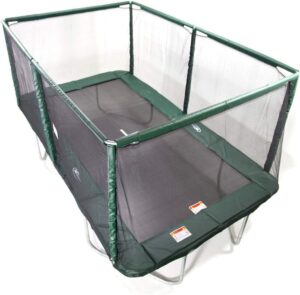
Square Trampolines
Square trampolines offer a balance between the round and rectangular types. They provide a good bounce across the entire surface and are suitable for recreational use as well as practicing tricks. Square trampolines are a versatile choice for users who want a combination of bounce quality and jumping space.
Mini Trampolines
Mini trampolines, also known as rebounders, are smaller in size and designed for individual use. They are often used for low-impact exercises and indoor bouncing. Mini trampolines are portable and can be easily stored, making them a convenient option for those with limited space.
They are ideal for younger children and toddlers.
Check Your Size and Space Requirements
Outdoor trampolines are generally sized in between 8 feet to 20 feet. If the trampoline is round , this size will refer to the diameter. If the trampoline is rectangular the size will refer to the longest length.
Opting for the largest trampoline possible will ensure it’s suitable for children as they grow older and taller. It will also leave room for more gymnastic type skills to be performed.
- Small trampolines are around 8 to 12 feet.
- The most popular trampolines are 12 to 14 feet.
- Large trampolines are 16 feet or longer.
Round trampoline size guide:
- 8 ft and 10 ft trampolines are suitable for smaller children (under 10).
- 12 ft and 14 ft trampolines are suitable for any age children including teens. They’ll handle two children at a time as well.
- 15 ft and bigger are more suitable for teenagers and larger families that will have multiple children on at one time. Smaller children won’t have enough weight to get much bounce
Rectangular trampoline size guide:
- 7 ft x 10 ft are suitable for smaller children (under 10)
- 8 ft x 12 ft is a popular size for children and teens. plenty of space for somersaults and flips. Two children could use it at the same time.
- 9 ft x 15 ft are ideal for teenagers who want to link round-off back tuck or back handspring
- Full-size trampolines used in competitions and professional facilities are 10 ft x 17ft. Assuming the trampoline is of good quality then this size will be suitable for adults and teenagers performing advanced routines.
Consider the factors below carefully before deciding on a trampoline size:
Backyard Space
Measure the available space in your backyard to ensure that it can accommodate the trampoline size you’re considering. Leave a buffer zone around the trampoline for safe access and to prevent any potential collisions with other objects.
Safety nets are made from a flexible material so when a jumper collides with the net there shouldn’t be anything within a foot or two or they will still impact it.
Clearance Height
Consider the height of your surroundings, such as trees, overhead power lines, or structures, to ensure that there is sufficient clearance above the trampoline. Make sure the trampoline is placed in an area where users can jump freely without any obstructions.
Surface and Placement
Choose a suitable surface for placing the trampoline. Ideally, the surface should be flat, level, and free from debris. Avoid placing the trampoline on concrete or other hard surfaces, as they can increase the risk of injuries. Grass or soft ground is preferable, as it provides a cushioning effect.
Anchoring and Stabilization
Consider whether the trampoline requires anchoring or stabilization. Some trampolines come with anchoring systems to secure them to the ground, especially in areas prone to strong winds. Ensuring the trampoline is stable and properly anchored enhances safety and prevents tipping or movement during use.
In-ground or Above ground
In-ground trampolines are safer but will require more time, money and effort to set up. Pretty much every trampoline on the market can be placed either above-ground or in-ground however, you will need to carefully consider the size implications for the hole in which your in-ground trampoline will sit.

Choosing to place a trampoline in ground will require plenty of work to dig out a large enough hole and secure it with concrete.
Putting a normal trampoline into the ground is perfectly OK. It will reduce the chance of injury as it will be level with the ground and it will probably look a lot nicer.
However, there are a lot of factors to consider when digging the hole for the trampoline to go into.
- Size of the hole
- Drainage (nobody wants a swimming pool under the trampoline!)
- Construction of the walls and floor
- Being level
The type of trampoline that goes into the ground isn’t a major factor. But do concentrate on the quality of the hole and the retaining walls.
Trampoline parks and professional gym facilities sink trampolines into the ground for the very same reasons as those at home albeit they are usually indoors.
Features and Accessories
When selecting an outdoor trampoline, check which of the following features and accessories it comes with. Some features can be brought separately.
Enclosures and Safety Nets
Choose a trampoline that includes a safety enclosure or netting system. These features prevent users from falling off the trampoline and minimize the risk of accidents. Ensure that the enclosure is securely attached and made from durable materials.
Ladders and Steps
Trampolines that come with ladders or steps provide convenient access for users, especially for children or individuals with limited mobility. Ladders or steps should be sturdy, easy to climb, and securely attached to the trampoline frame.
Spring or Springless Designs
Trampolines can either have traditional springs or springless designs. Springless trampolines use elastic bands or bungee cords instead of springs, reducing the risk of pinching or injuries caused by contact with springs. However, springs almost always produce more bounce than bungee cords.
Weather and UV Resistance
Ensure that the trampoline materials are weather-resistant and can withstand various weather conditions. Look for features such as rust-resistant frames and UV-resistant jumping surfaces. A trampoline built to withstand outdoor elements will last longer and require less maintenance.
Budget Considerations
Consider the following budget factors when choosing an outdoor trampoline:
Price Range
Trampolines come in a wide range of prices, depending on factors such as size, brand, features, and quality. If a price looks to good to be true, there’s normally a reason behind it. Maybe there’s no enclosure or the frame quality is flimsy.
Choosing a more expensive brand is advisable if you want your trampoline to last for at least five years (which it should).
Longevity and Warranty
Check the warranty provided by the manufacturer to ensure that you’re protected against any defects or issues. Consider the expected lifespan of the trampoline and factor that into your purchasing decision. Investing in a durable trampoline that comes with a generous warranty can save you money in the long run.
Maintenance and Replacement Parts
Consider the maintenance requirements of the trampoline. You should inspect your trampoline regularly to check for damage and over time it’s possible that parts need to be replaced. The most common parts that need replacing on a trampoline are:
- Springs
- The bed
- Enclosure or netting
Evaluate the availability and cost of replacement parts to ensure that you can easily maintain and repair the trampoline when needed.
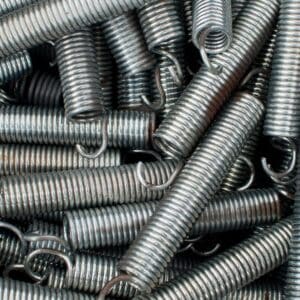
Additional Costs (Installation, Delivery)
Take into account any additional costs associated with the trampoline, such as installation or delivery fees. Some trampolines require professional assembly, while others can be easily set up by the buyer—factor in these costs when determining the overall budget for your trampoline purchase.
Comparing Features and Prices
Compare the features, specifications, and prices of different trampolines to find the best option that meets your requirements and budget. Consider factors such as size, safety netting, and warranty when comparing different models.
Installation and Maintenance
Once you’ve selected the right outdoor trampoline, follow these guidelines for installation and maintenance:
Assembly Instructions
Carefully read and follow the manufacturer’s assembly instructions step by step. Ensure that all components are correctly attached and secured. If needed, seek professional help for assembly to ensure the trampoline is set up correctly.
Regular Cleaning and Inspection
Regularly clean the trampoline to remove dirt, debris, and leaves. Inspect the frame, jumping surface, springs, and safety enclosure for any signs of wear, damage, or rust. Address any issues promptly to maintain the trampoline’s safety and longevity.
Repairs and Replacements
If any parts of the trampoline become damaged or worn out, contact the manufacturer or authorized dealers for replacement parts. Avoid using the trampoline if it is in need of repair, as it may pose safety risks.
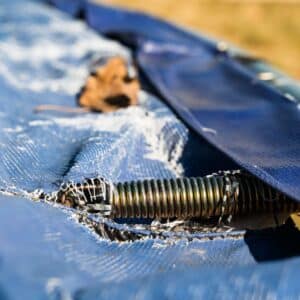
Seasonal Storage
If you live in an area with harsh winters or during extended periods of non-use, consider how to winterize your trampoline indoors or in a sheltered area. Follow the manufacturer’s guidelines for proper disassembly and storage to prevent damage and prolong the lifespan of the trampoline.
Safety Considerations
When deciding how to choose a trampoline, safety should be a top priority. Here are some important safety considerations to keep in mind:
Quality and Durability
Opt for trampolines that are made from high-quality materials and are built to withstand outdoor conditions. Look for sturdy frames, durable springs or bungee cords, and a robust jumping surface. Investing in a well-built trampoline ensures longevity and reduces the risk of accidents or equipment failure.
Safety Certifications
Check if the trampoline you’re considering has undergone safety certifications. Look for certifications such as ASTM (American Society for Testing and Materials) or TUV (Technischer Überwachungsverein) to ensure that the trampoline meets the required safety standards.
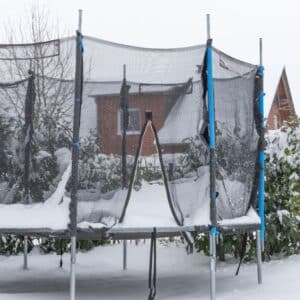
Conclusion
Knowing how to choose a trampoline first involves considering who will use it and then factors such as shape, size and weight limits.
Now that you have a better understanding of how to choose a trampoline you can make an informed decision based on your specific needs and preferences.
FAQs
Are trampolines safe for children?
Trampolines can be safe for children when appropriate safety measures are in place, such as enclosures and adult supervision. It’s essential to follow safety guidelines and ensure that the trampoline is age-appropriate.
Can adults use outdoor trampolines?
Yes, outdoor trampolines can be used by adults. However, it’s important to check the weight capacity and ensure that the trampoline is suitable for adult use.
What is the ideal trampoline size for a small backyard?
For a small backyard, a trampoline with a diameter of 8 to 10 feet is typically suitable. Ensure that there is enough clearance around the trampoline for safe jumping.
How long do outdoor trampolines last?
The lifespan of an outdoor trampoline depends on various factors such as quality, usage, and maintenance. A well-maintained trampoline can last anywhere from 5 to 10 years or longer.
Can I have a trampoline in my front yard?
This will all depend on where you live.
There are no specific laws (that I’m aware of) that ban trampolines from being in the front yard. Maybe you don’t have room in the backyard or it will just look better at the front! But many areas of housing development will have specific rules that cover what you can and can’t have at the front so read these first before you decide anything.
You should also be a good neighbor and check with those around you to see if they have any major objections.
Also, bear in mind that you will be liable for anyone who injures themselves on your trampoline – even someone who jumps without permission. Can you secure your trampoline when it’s not in use? If not, I would advise putting the trampoline somewhere else or taking advice from a legal professional.
Can you jump on a trampoline while pregnant?
The short and safe answer is no.
The risk of a fall whilst jumping is high, especially in later pregnancy and there are much safer ways to exercise during pregnancy.
However using a trampoline in early pregnancy, or before you realize you are pregnant, probably won’t cause any harm. A small bouncing motion in the first trimester can still be OK and the rhythm may even soothe the baby.
Always consult with a doctor or midwife to discuss the best types of exercise whilst pregnant and reduce the chances of injury as much as possible. So for that reason avoid using a trampoline whilst pregnant.
The exact same advice is true if you are wondering can jumping on a trampoline induce labor?
It’s just not a safe way to find out! The risk of tripping, falling or losing balance is higher with the large bump and your body will be more injury-prone as well. Even getting on and off the trampoline will be more hazardous whilst pregnant.
- How To Get Over a Mental Block In Gymnastics: A Complete Guide
 Gymnastics is a sport that requires not only physical strength and skill but also mental strength. When a gymnast feels like they cannot attempt a… Read more: How To Get Over a Mental Block In Gymnastics: A Complete Guide
Gymnastics is a sport that requires not only physical strength and skill but also mental strength. When a gymnast feels like they cannot attempt a… Read more: How To Get Over a Mental Block In Gymnastics: A Complete Guide - Find The Best Leotard For Girls (Guide)
 Finding an ideal leotard for girls isn’t just about picking a dazzling design that sparkles (although it does help!). The leotard has to fit perfectly,… Read more: Find The Best Leotard For Girls (Guide)
Finding an ideal leotard for girls isn’t just about picking a dazzling design that sparkles (although it does help!). The leotard has to fit perfectly,… Read more: Find The Best Leotard For Girls (Guide) - The Best Gymnastics Shorts (Our Top Picks)
 The best gymnastics shorts are designed to be worn over the top of a leotard providing additional coverage around the upper legs, whilst allowing gymnasts… Read more: The Best Gymnastics Shorts (Our Top Picks)
The best gymnastics shorts are designed to be worn over the top of a leotard providing additional coverage around the upper legs, whilst allowing gymnasts… Read more: The Best Gymnastics Shorts (Our Top Picks) - Decathlon Leotards – Are They Any Good?
 If you’re in the market for a new leotard, you may be wondering if Decathlon leotards are any good considering the low cost of their… Read more: Decathlon Leotards – Are They Any Good?
If you’re in the market for a new leotard, you may be wondering if Decathlon leotards are any good considering the low cost of their… Read more: Decathlon Leotards – Are They Any Good? - A Complete Guide to Gymnastics Hand Rips
 Are you tired of dealing with painful gymnastics rips on your hands from training? Look no further – this article offers a comprehensive approach to… Read more: A Complete Guide to Gymnastics Hand Rips
Are you tired of dealing with painful gymnastics rips on your hands from training? Look no further – this article offers a comprehensive approach to… Read more: A Complete Guide to Gymnastics Hand Rips - Is Gymnastics Dangerous? (Facts and Comparisons)
 Gymnastics is acknowledged as a highly technical and physically demanding sport. It inherently carries a risk of injury, which is why most coaches and clubs… Read more: Is Gymnastics Dangerous? (Facts and Comparisons)
Gymnastics is acknowledged as a highly technical and physically demanding sport. It inherently carries a risk of injury, which is why most coaches and clubs… Read more: Is Gymnastics Dangerous? (Facts and Comparisons)
